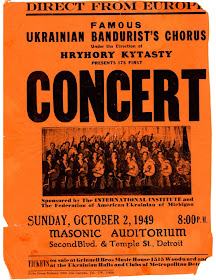 |
| Andy Birko plays a bandura of his own design, November 12, 2013. Photo by Laurie Kay Sommers |
.jpg) |
| The Ukranian Bandurist Chorus in performance at the Sterling Heights Performing Arts Center, April 20, 2013. Birko is sixth from the right, in the front row. Photo by Laurie Kay Sommers |
The UBC moved to Detroit in 1949, drawn to the city by plentiful auto industry jobs. With assistance from the International Institute and the Federation of American Ukrainians of Michigan, the ensemble held its first North American concert on October 2, 1949 at Detroit’s Masonic Auditorium. The performance launched a grand tour of major US and Canadian cities. Although the UBC now has membership drawn from across North America, Detroit remains its official home.
 |
| Flyer from the UBC's first North American concert after emigration. From the UBC archives, courtesy of Wolodya Murha. |
 |
| Birko in his workshop, comparing a hand-carved scroll and one he produced on this CNC machine, November 12, 2013. Photo by Laurie Kay Sommers. |
Hear Andy Birko describe the characteristic features of the bandura and what he hopes to accomplish with his own bandura designs.
Visit Andy Birko’s workshop and hear him discuss his approach to bandura making.


No comments:
Post a Comment
Your post will be moderated by MSU Museum staff